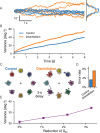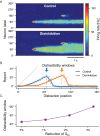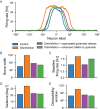Linking microcircuit dysfunction to cognitive impairment: effects of disinhibition associated with schizophrenia in a cortical working memory model
- PMID: 23203979
- PMCID: PMC3948492
- DOI: 10.1093/cercor/bhs370
Linking microcircuit dysfunction to cognitive impairment: effects of disinhibition associated with schizophrenia in a cortical working memory model
Abstract
Excitation-inhibition balance (E/I balance) is a fundamental property of cortical microcircuitry. Disruption of E/I balance in prefrontal cortex is hypothesized to underlie cognitive deficits observed in neuropsychiatric illnesses such as schizophrenia. To elucidate the link between these phenomena, we incorporated synaptic disinhibition, via N-methyl-D-aspartate receptor perturbation on interneurons, into a network model of spatial working memory (WM). At the neural level, disinhibition broadens the tuning of WM-related, stimulus-selective persistent activity patterns. The model predicts that this change at the neural level leads to 2 primary behavioral deficits: 1) increased behavioral variability that degrades the precision of stored information and 2) decreased ability to filter out distractors during WM maintenance. We specifically tested the main model prediction, broadened WM representation under disinhibition, using behavioral data from human subjects performing a spatial WM task combined with ketamine infusion, a pharmacological model of schizophrenia hypothesized to induce disinhibition. Ketamine increased errors in a pattern predicted by the model. Finally, as proof-of-principle, we demonstrate that WM deteriorations in the model can be ameliorated by compensations that restore E/I balance. Our findings identify specific ways by which cortical disinhibition affects WM, suggesting new experimental designs for probing the brain mechanisms of WM deficits in schizophrenia.
Keywords: NMDAR hypofunction; disinhibition; prefrontal cortex; schizophrenia; working memory.
Figures







References
-
- Amit DJ, Brunel N. Model of global spontaneous activity and local structured activity during delay periods in the cerebral cortex. Cereb Cortex. 1997;7:237–252. - PubMed
-
- Anand A, Charney DS, Oren DA, Berman RM, Hu XS, Cappiello A, Krystal JH. Attenuation of the neuropsychiatric effects of ketamine with lamotrigine: support for hyperglutamatergic effects of N-methyl-d-aspartate receptor antagonists. Arch Gen Psychiatry. 2000;57:270–276. - PubMed
-
- Anticevic A, Repovs G, Corlett PR, Barch DM. Negative and nonemotional interference with visual working memory in schizophrenia. Biol Psychiatry. 2011;70:1159–1168. - PubMed
-
- Badcock JC, Badcock DR, Read C, Jablensky A. Examining encoding imprecision in spatial working memory in schizophrenia. Schizophr Res. 2008;100:144–152. - PubMed
Publication types
MeSH terms
Substances
Grants and funding
LinkOut - more resources
Full Text Sources
Other Literature Sources
Medical

